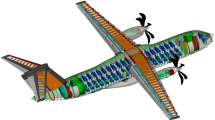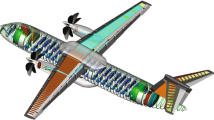Abstract
In this study, the aerodynamics of wings using an active high-lift system are investigated. The target is the flight mechanical description of the spanwise forces and resulting moments and the influence of the active high-lift system to their distribution. The high-lift system is a blown flap system divided into six segments per wing. Each segment is assumed to be individually controlled, so the system shall be used for aircraft control and system failure management. This work presents a flight mechanical sub-model for the simulation of flight dynamics, which has been derived from high-fidelity CFD results. An assessment of single-segment blowing system failures will be presented including recommendations for compensation of either lift or rolling moment loss. For this investigation, the compensation is required to act at the same wing side on which the failure appears. Thus, the potential for an increase of system reliability shall be proven. The results show that less performance investment in terms of pressurized air is necessary to compensate the rolling moment of a failing segment instead of its lift. However, large blowing performance increases for the remaining wing segments that occur for some of the failure cases.














Similar content being viewed by others
Notes
Release 2007b by Mathworks®.
Institute of Aircraft Design and Lightweight Structures (IFL), TU Braunschweig.
Abbreviations
- B :
-
Failure model area (–)
- C :
-
Coefficient or derivative (–)
- \(\tilde{C}_{L}\) :
-
Lift coefficient for segment failure (–)
- \(C_{L,loc}\) :
-
Local lift coefficient (–)
- \(dC_{L}\) :
-
Spanwise lift coefficient increment (–)
- \(c_{loc}\) :
-
Local wing chord length (m)
- \(c_{MAC}\) :
-
Wing mean aerodynamic chord length (m)
- \(C_{\mu }\) :
-
Jet momentum coefficient (–)
- \({C}_{\mu ,loc}\) :
-
Local jet momentum coefficient (–)
- \(c_{p}\) :
-
Pressure coefficient (–)
- E :
-
Segment failure factor (–)
- F :
-
Force (N)
- I :
-
Mass inertia (kgm2)
- \(\hat{k}\) :
-
Mapping gradient for local jet momentum (–)
- k :
-
Lift Gradient with respect to jet momentum (–)
- M :
-
Mach number (–)
- m :
-
Mass (kg)
- \(\dot{m}\) :
-
Mass flow (kg/s)
- P :
-
Jet momentum performance factor (–)
- p, q, r :
-
Angular rates (°/s)
- \(q_{\infty },\bar{q}\) :
-
Dynamic pressure (N/m2)
- S :
-
Main wing area (m2)
- \(u_{k},v_{k},w_{k}\) :
-
Aircraft velocity (inertial frame) (m/s)
- \(v_{jet}\) :
-
Fluid velocity (m/s)
- x, y, z :
-
Aircraft position (m)
- Y :
-
Dimensionless wingspan location (–)
- \(\alpha\) :
-
Angle of attack (°)
- \(\varPhi ,\varTheta ,\varPsi\) :
-
Aircraft attitude angles (°)
- \({C_{\mu }}\) :
-
With respect to jet momentum coefficient
- fl :
-
Flap
- i :
-
Number of wing segment
- j :
-
Normalized wingspan coordinate
- jet :
-
Jet of the blowing system
- L :
-
Lift
- l :
-
Rolling moment
- n :
-
Number of jet momentum setting
- 6-DOF:
-
Six degrees of freedom
- BLC:
-
Boundary Layer Control
- CC:
-
Circulation Control
- CFD:
-
Computational Fluid Dynamics
- DLR:
-
Deutsches Zentrum f++r Luft- und Raumfahrt (German Aerospace Center)
- IBF:
-
Internally blown flaps
- NASA:
-
National Aeronautics and Space Administration
- PrADO:
-
Preliminary Aircraft Design and Optimization [tool]
- SFB:
-
Sonderforschungsbereich (Collaborative Research Center)
- STOL:
-
Short Take-off and Landing
References
Norton, B.: STOL Progenitors—The Technology Path to a Large STOL Transport and the C-17A. American Institute of Aeronautics and Astronautics, Reston, VA, USA (2002)
Campbell, J.P.: Status of V/STOL research and development in the United States. AIAA J. Aircr. 1(3), 97–106 (1964). AIAA No. 63-482
Griffin, R.N., Holzhauser, C.A., Weiberg, J.A.: Large-scale wind-tunnel tests of an airplane model with an unswept, aspect-ratio-10 wing, two propellers, and blowing flaps. Memorandum 12-3-58A, NACA (1958)
Weiberg, J.A., Page, V.R.: Large-scale wind-tunnel tests of an airplane model with an unswept, aspect-ratio-10 wing, four propellers, and blowing flaps. Technical Note D-25, NASA (1959)
Weiberg, J.A., Holzhauser, C.A.: Stol characteristics of a propeller-driven, aspectratio-10, straight-wing airplane with boundarylayer control flaps, as estimated from largescale wind-tunnel tests. Technical Note D-1032, NASA (1961)
Dansby, T., Garrard, W.C.J., Ryle, D.M., Sullivan, L.J.: V/STOL development of the C-130 Hercules. AIAA J. Aircr. 1(5), 242–252 (1964)
Quigley, H.C., Innis, R.C.: Handling qualities and operational problems of a large four-propeller STOL airplane. Technical Note D-1647, NASA (1963)
Quigley, H.C., Lawson, H.F.: Simulator study of the lateral-directional handling qualities of a large four-propellered STOL transport airplane. Technical Note D-1773, NASA (1963)
Werner-Westphal, C., Heinze W., Horst, P.: Multidisciplinary integrated preliminary design applied to future green aircraft configurations. In: 45th AIAA Aerospace Sciences Meeting and Exhibit (American Institute of Aeronautics and Astronautics, 2007). doi:10.2514/6.2007-655
Teichel, S., Dörbaum, M., Misir, O., Merkert, A., Mertens, A., Seume, J.R., Ponick, B.: Design considerations for the components of electrically powered active high-lift systems in civil aircraft. CEAS Aeronaut. J. 6, 49–67 (2014)
Seume, J.R., Teichel, S., Burnazzi, M., Schwerter, M., Behr, C., Rudenko, A., Schmitz, A., Dörbaum, M., Atalayer, C.: SFB 880—efficient flight. In: Proceedings of the 62nd Deutscher Luft- und Raumfahrtkongress 2013 (2013)
Sakurai, S., Fox, S., Beyer, K., Lacy, D., Johnson, P., Wells, S., Noble, J., Meredith, P., Huynh, N., Christianson, R., et al. Multi-function trailing edge devices and associated methods. US Patent 2005/0011994 App. 10/860,438 (2005)
Burnazzi, M., Radespiel, R.: Design and analysis of a droop nose for coanda flap applications. J. Aircr 51(5):1567–1579 (2014). doi:10.2514/1.C032434
Burnazzi, M., Radespiel, R.: Synergies between suction and blowing for active high-lift flaps. CEAS Aeronaut. J. 6(2):305–318 (2015). doi:10.1007/s13272-014-0146-8
Keller, D., Rudnik, R.: Integration aspects of lift augmentation systems on the aerodynamics of a high-lift configuration. In: Radespiel, R., Semaan, R. (eds.) SFB 880—fundamentals of high-lift for future commertial aircraft, Biennial Report, pp 145–156. Braunschweig, TU Braunschweig—Campus Forschungsflughafen (2015)
Diekmann, J.H., Hahn, K.U.: Effect of an active high-lift system failure during landing approaches. CEAS Aeronaut. J. 6(2):181–196 (2015). doi:10.1007/s13272-014-0139-7
Gerhold, T.: Overview of the hybrid RANS code TAU. In: MEGAFLOW—numerical flow simulation for aircraft design. Notes on Numerical Fluid Mechanics and Multidisciplinary Design, vol 89 (Hrsg.) N. Kroll and J. Fassbender (Springer, 2005), S. 81–92
Spalart, P., Allmaras, S.: A one–equation turbulence model for aerodynamic–flows. In: 30th Aerospace Sciences Meeting and Exhibit, 92–0439 (AIAA, 1992)
Spalart, P., Shur, M.: On the sensitization of turbulence models to rotation and curvature. Aerosp. Sci. Technol. 1(5):297–302 (1997)
Acknowledgements
This work has been supported by the provision of particular CFD results for the spanwise aerodynamics of the wing with DLR’s TAU code by Dennis Keller. The reference aircraft design has been developed by Wolfgang Heinze with PrADO. The research is conducted within the framework of the Sonderforschungsbereich 880.
Author information
Authors and Affiliations
Corresponding author
Additional information
This paper is based on a presentation at the German Aerospace Congress, September 13–15, 2016, Braunschweig, Germany.
Rights and permissions
About this article
Cite this article
Diekmann, J.H., Keller, D., Faez, E. et al. Flight mechanics model for spanwise lift and rolling moment distributions of a segmented active high-lift wing. CEAS Aeronaut J 8, 625–635 (2017). https://doi.org/10.1007/s13272-017-0261-4
Received:
Revised:
Accepted:
Published:
Issue Date:
DOI: https://doi.org/10.1007/s13272-017-0261-4




